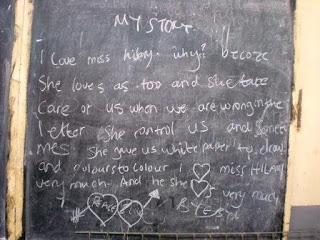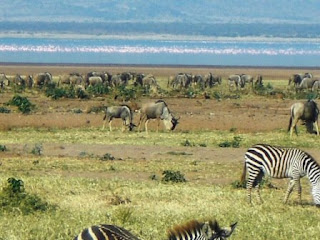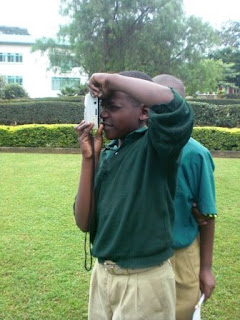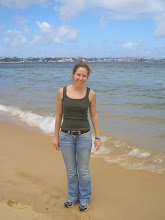Arusha School FUN DAY!
Since the first day we began working at Arusha Primary School, we heard the kids talking about the "Sports Day" that was coming up at the school in late July. About a week before the designated date, though, our students informed us that Sports Day had been cancelled for some reason unknown to them. They didn't seem at all surprised, but to us the situation was heartbreaking because we knew how much the kids had been looking forward to Sports Day. One of us - Lindsay, I believe - then had a great idea: Why not put on a field day for the kids on our own? We set the date as the last Wendesday in Arusha. Although this was a particularly hectic time - during that week we were wrapping up our teaching projects, after school programs, and preparing for the final LTP exhibition - we were determined to pull this off. We spent the vast majority of Tuesday and Wednesday preparing - buying supplies, making posters, arranging with food vendors, etc. I was highly preoccupied on Tuesday with my book-making class party, so my personal contribution on that day was blowing up 40 balloons in the evening (it works, right?) Somewhere along the line, the event acquired the name "Fun Day" (cough, Alia and Ami), which the other six of us found hilarious. In the end, the day came together amazingly. There were sack races, three-legged races, games of musical chairs, tug-of-war games, signing of banners, dance parties, an exhibit from Alia's after-school art program, football (soccer) games, and free chungwa (oranges) and peanuts. The kids had tons of fun, although I would argue that their American teachers enjoyed themselves even more. It was amazing how easily pleased the Tanzanian children are - such simple events made them happy beyond belief.

 Signing the banners. There was one for us to take back to the Center for Documentary Studies at Duke, and one to leave at Arusha School.
Signing the banners. There was one for us to take back to the Center for Documentary Studies at Duke, and one to leave at Arusha School.
LTP Final Exhibition
On Friday, our last day in Arusha, the LTP Final Exhibition began. We spent much of Thursday taping all of our students' LTP projects to the outside walls (in a covered area) of a local cultural cafe called Via Via (also one of our favorite dinner and music venues). The exhibition ran both Friday and Saturday. All were welcome, although all the teachers and students at the six schools at which we taught were particularly encouraged to come, and multiple education and government officials were also in attendance. The turnout on Friday was great, and it was wonderful to see all the positive reactions to the programs. I think we all have high hopes for the continuance of LTP teaching in Arusha and beyond.In the end, we calculated that throughout our two months in Arusha, we taught over 750 students (not counting after-school programs). In the midst of lots of goodbye tears, hugs, and kisses exchanged with those who had become so special to us during our two months in Arusha, the eight of us reflected on how meaningful, life-changing, and unforgettable our time there had been. Many of us, including myself, agreed that there's no way we won't return at some point.
It's been an amazing ride so far.














































